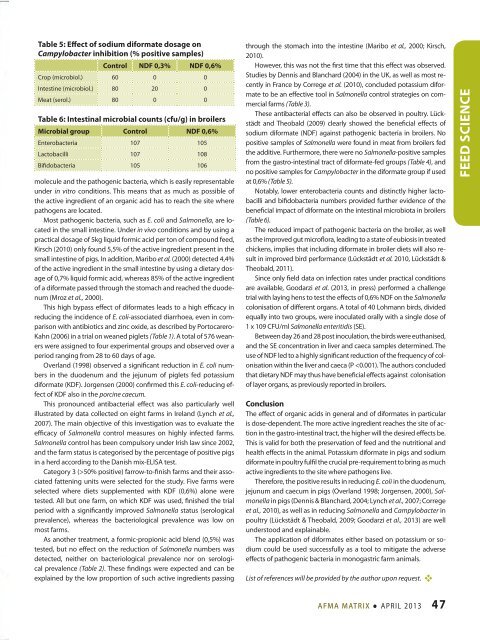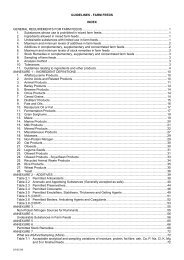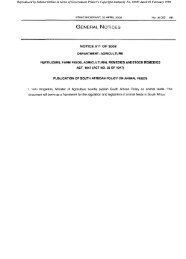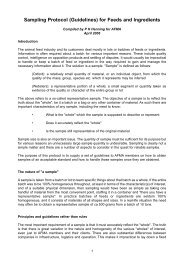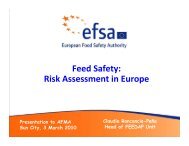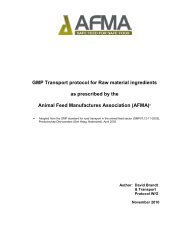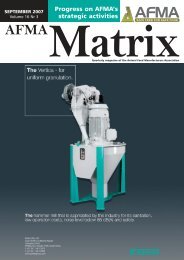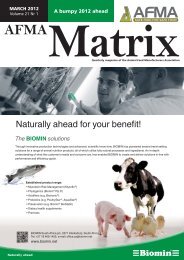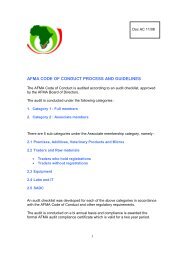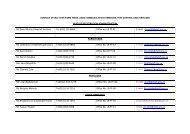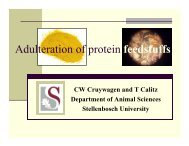Create successful ePaper yourself
Turn your PDF publications into a flip-book with our unique Google optimized e-Paper software.
Table 5: Effect of sodium diformate dosage on<br />
Campylobacter inhibition (% positive samples)<br />
Control NDF 0,3% NDF 0,6%<br />
Crop (microbiol.) 60 0 0<br />
Intestine (microbiol.) 80 20 0<br />
Meat (serol.) 80 0 0<br />
Table 6: Intestinal microbial counts (cfu/g) in broilers<br />
Microbial group Control NDF 0,6%<br />
Enterobacteria 107 105<br />
Lactobacilli 107 108<br />
Bifidobacteria 105 106<br />
molecule and the pathogenic bacteria, which is easily representable<br />
under in vitro conditions. This means that as much as possible of<br />
the active ingredient of an organic acid has to reach the site where<br />
pathogens are located.<br />
Most pathogenic bacteria, such as E. coli and Salmonella, are located<br />
in the small intestine. Under in vivo conditions and by using a<br />
practical dosage of 5kg liquid formic acid per ton of compound feed,<br />
Kirsch (2010) only found 5,5% of the active ingredient present in the<br />
small intestine of pigs. In addition, Maribo et al. (2000) detected 4,4%<br />
of the active ingredient in the small intestine by using a dietary dosage<br />
of 0,7% liquid formic acid, whereas 85% of the active ingredient<br />
of a diformate passed through the stomach and reached the duodenum<br />
(Mroz et al., 2000).<br />
This high bypass effect of diformates leads to a high efficacy in<br />
reducing the incidence of E. coli-associated diarrhoea, even in comparison<br />
with antibiotics and zinc oxide, as described by Portocarero-<br />
Kahn (2006) in a trial on weaned piglets (Table 1). A total of 576 weaners<br />
were assigned to four experimental groups and observed over a<br />
period ranging from 28 to 60 days of age.<br />
Overland (1998) observed a significant reduction in E. coli numbers<br />
in the duodenum and the jejunum of piglets fed potassium<br />
diformate (KDF). Jorgensen (2000) confirmed this E. coli-reducing effect<br />
of KDF also in the porcine caecum.<br />
This pronounced antibacterial effect was also particularly well<br />
illustrated by data collected on eight farms in Ireland (Lynch et al.,<br />
2007). The main objective of this investigation was to evaluate the<br />
efficacy of Salmonella control measures on highly infected farms.<br />
Salmonella control has been compulsory under Irish law since 2002,<br />
and the farm status is categorised by the percentage of positive pigs<br />
in a herd according to the Danish mix-ELISA test.<br />
Category 3 (>50% positive) farrow-to-finish farms and their associated<br />
fattening units were selected for the study. Five farms were<br />
selected where diets supplemented with KDF (0,6%) alone were<br />
tested. All but one farm, on which KDF was used, finished the trial<br />
period with a significantly improved Salmonella status (serological<br />
prevalence), whereas the bacteriological prevalence was low on<br />
most farms.<br />
As another treatment, a formic-propionic acid blend (0,5%) was<br />
tested, but no effect on the reduction of Salmonella numbers was<br />
detected, neither on bacteriological prevalence nor on serological<br />
prevalence (Table 2). These findings were expected and can be<br />
explained by the low proportion of such active ingredients passing<br />
through the stomach into the intestine (Maribo et al., 2000; Kirsch,<br />
2010).<br />
However, this was not the first time that this effect was observed.<br />
Studies by Dennis and Blanchard (2004) in the UK, as well as most recently<br />
in France by Correge et al. (2010), concluded potassium diformate<br />
to be an effective tool in Salmonella control strategies on commercial<br />
farms (Table 3).<br />
These antibacterial effects can also be observed in poultry. Lückstädt<br />
and Theobald (2009) clearly showed the beneficial effects of<br />
sodium diformate (NDF) against pathogenic bacteria in broilers. No<br />
positive samples of Salmonella were found in meat from broilers fed<br />
the additive. Furthermore, there were no Salmonella-positive samples<br />
from the gastro-intestinal tract of diformate-fed groups (Table 4), and<br />
no positive samples for Campylobacter in the diformate group if used<br />
at 0,6% (Table 5).<br />
Notably, lower enterobacteria counts and distinctly higher lactobacilli<br />
and bifidobacteria numbers provided further evidence of the<br />
beneficial impact of diformate on the intestinal microbiota in broilers<br />
(Table 6).<br />
The reduced impact of pathogenic bacteria on the broiler, as well<br />
as the improved gut microflora, leading to a state of eubiosis in treated<br />
chickens, implies that including diformate in broiler diets will also result<br />
in improved bird performance (Lückstädt et al. 2010, Lückstädt &<br />
Theobald, 2011).<br />
Since only field data on infection rates under practical conditions<br />
are available, Goodarzi et al. (<strong>2013</strong>, in press) performed a challenge<br />
trial with laying hens to test the effects of 0,6% NDF on the Salmonella<br />
colonisation of different organs. A total of 40 Lohmann birds, divided<br />
equally into two groups, were inoculated orally with a single dose of<br />
1 x 109 CFU/ml Salmonella enteritidis (SE).<br />
Between day 26 and 28 post inoculation, the birds were euthanised,<br />
and the SE concentration in liver and caeca samples determined. The<br />
use of NDF led to a highly significant reduction of the frequency of colonisation<br />
within the liver and caeca (P


